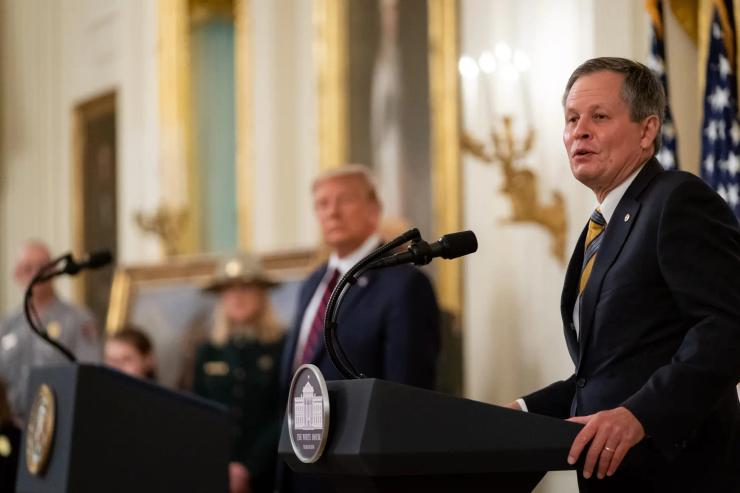The News
Senate Republicans fell far short of their expectations in the 2022 midterms. Then Steve Daines took over their campaign arm and made big strategic changes: Playing favorites in primaries, muscling out weak candidates and bringing in wealthy recruits.
Republicans are about to find out if they worked.
“I feel a lot like a college basketball coach in March Madness with 5 or 6 seconds left on the clock, with either a tied game or down one,” Daines told Semafor. It’s now up to his candidates to “go make plays and see how many of these we can win.”
He’s confident enough to say Republicans are “going to retake the Senate majority,” but that’s as far as he’ll go in the prediction game. And he’s already ruled out that idea that a big night would lead to a surprise bid for GOP leader.
After Democrats held onto the Senate two years ago, Daines aggressively intervened in primaries and prioritized candidates that could win over the center in general elections. He developed a strategy where Republicans could retake the Senate just with red states, and expand the Senate map if the presidential race tightened.
The Montana Republican took pains to align with Donald Trump while also not letting him personally pick the party’s nominees. And after making an early endorsement of the former president, Daines worked closely with him on strategy; Trump later relaxed his past resistance to voting by mail and backed a prior critic, Mike Rogers, in the Michigan Senate race.
Daines’ moves blended throwback party-boss politics with Trump populism, and they amounted to a break from Rick Scott, the party’s previous Senate campaigns chief who stayed neutral in key primaries. If Daines fails to deliver his party control of the Senate, he will face questions about his decisions. But delivering a majority, especially a sizable one, would validate his approach for the next campaigns chief ahead of a tough 2026 midterm cycle.
Republicans still have not fixed their fundraising problem among candidates, requiring creative spending tactics from Daines as well as the recruitment of aspiring senators with some personal wealth. And while last-minute electoral surprises happen (and did in 2022), Republicans are competitive in at least five states currently held by Democrats.
Yet the opposing party isn’t impressed: David Bergstein, a spokesperson for the Democratic Senatorial Campaign Committee, said the GOP “candidates’ flaws outweighed their fortunes.”
“Their decision to prioritize their recruits’ personal wealth over all else left them with a roster of damaged candidates who are hurting their prospects across the entire Senate map,” Bergstein said.
In this article:
Know More
Daines engineered a GOP landscape that featured a divisive primary race in Ohio (where the NRSC was neutral) but was otherwise relatively placid. The Democratic incumbents he’s trying to unseat spent the summer running far ahead of their party’s presidential hopefuls, but Daines figured the races would end up hinging far more on the presidential race than ticket-splitters.
“If you have good candidates running good campaigns with good messages, these states would start to track as closely on the Senate ballot as the presidential ballot,” Daines said. “We’ve got literally tied races in the Blue Wall states at the moment.”
Scott adopted a laissez-faire approach to Republican primaries, feuded with GOP leader Mitch McConnell and set high expectations in 2022. Daines played it differently, working to dissuade candidates who would have given the GOP divisive primaries and lowered the party’s chances of winning.
“It’s not so much in finding the one candidate that could win, but it’s probably working to make sure we don’t have candidates that can’t win,” Daines said.
He helped keep out Sandy Pensler in Michigan, Doug Mastriano in Pennsylvania and Scott Mayer in Wisconsin. He worked with McConnell to bring Gov. Jim Justice into West Virginia’s race, squashing conservative Rep. Alex Mooney, W.Va., and leading eventually to the retirement of Sen. Joe Manchin and netting the GOP a seat early.
It’s rare for a campaign chief to take on the mission of defeating a home-state colleague, but Daines recruited Tim Sheehy to run against Democratic Sen. Jon Tester. He simultaneously prevented a primary run by Freedom Caucus Rep. Matt Rosendale.
Polls routinely show Tester trailing Sheehy. Should he somehow pull off a victory, it would complicate the GOP’s most straightforward path to the Senate majority.
“He closes. And I think he’ll close strong,” Sen. Michael Bennet, D-Colo., said of Tester.
Daines disagrees. “I just don’t see how he overcomes a Trump 20-point victory in Montana,” he said, adding: “This is not a personal issue between Jon Tester and myself. We just vote very differently.”
Even if he loses, Tester’s recent $30 million fundraising haul epitomizes a biennial problem for Republicans: Democrats tend to outraise them. Some of the wealthy candidates Daines recruited, like Eric Hovde in Wisconsin, have put their own money into their races, but that hasn’t made up for Democratic fundraising muscle.
Which has forced Daines’ NRSC to get creative by slashing some of the committee’s TV ads and retrenching with hybrid ads whose cost is shared by the committee and the candidates and candidate ads dressed-up as fundraising pleas.
Senate Leadership Fund president Steven Law, who at times quibbled with the campaign arm’s approach under Scott, said Daines is “maximizing the use of every dollar and taking advantage of the candidate’s broadcast discount. Democrats have even started using the same strategy, and that’s the sincerest form of flattery.”
Daines’ take: “We just redeploy those resources in a much more valuable way.” The two parties’ spending is “at parity, or close to that, in all these battleground states,” he added. “We haven’t seen that since 2014.”
Ten years ago, Republicans flipped the Senate in a wave that included Daines’ first win.
Burgess’s view
It’s a tale of two parties when it comes to Senate race strategy.
Sen. Gary Peters, D-Mich., has run Democrats’ campaign arm for two cycles, with a hands-off approach to primaries and prioritized incumbent protection. That steady approach gave him an expanded majority after his first run.
The dramatic changes Daines made for Republicans, however, could inspire the party the next couple cycles if they pay off. In fact, Daines said he’s already spoken to the presumed next Senate GOP campaigns chief, Sen. Tim Scott of South Carolina, about handing “over a strong organization and a strong balance sheet.”


